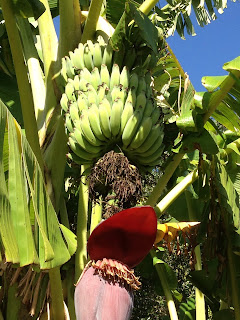Babylonstoren Estate with Maria Goosen.
Babylonstoren Estate with Maria Goosen.
I have previously told you about my friend Maria Gulen, whom I met when I was taking classes at the Academy of Tourism. Maria and I are druzam to this day, although she has now moved to another province. And then in 2013, we met from time to time and showed each other great new places to visit in Cape Town. This time Maria took me along the Wine Route to a farm called Babylon Storen.
The concept of this farm dates back to the days of Jan von Riebeck and the first vegetable gardens established in Cape Town to provide food to ships in need passing the Cape of Good Hope.
This farm grows organic products and it is from them that all dishes of the local restaurant are prepared. It's not easy to get into this restaurant, you need to sign up several months in advance. And as it seems to me from the photographs, this time we did not get to the restaurant. And the story of the menu will be waiting for you in future stories. And today I will tell you about the farm itself.
Back in 1692, the then governor of Cape Simon van der Stel handed over the Babylonstoren farm to the burgher Peter van der Bill. Prior to this, the Drakenstein Valley was inhabited by nomadic Khoisan communities for tens of centuries. So it was Peter van der Beel who planted the first vineyards on the farm and changed the watercourses to provide irrigation.
Some of the earliest farm buildings from that time remain on the farm today, such as the shipyard (farm yard) of Cape Babylonstoren, typical of the architectural style popular in the 17th and 18th centuries. As such, today it is considered to be one of the best-preserved farmsteads on the promontory.
The original buildings include a mansion built in 1777, the Koornhuis (for storing wheat), an old cellar, an ornate birdhouse, a dovecote, a sloping bell tower, and a historic gate, all dating back to the 1750s. The abandoned barn has been transformed into a modern Babel restaurant.
When new facilities were added to create the Farm Hotel, every effort was made to reflect the integrity of the original architecture and its beneficial relationship to the landscape and climate. And so Babylonstoren's signature look remains white walls of thick stone or primitive bricks, with ornate gables and thatched roofs, but with modern glass boxes (to accommodate the kitchen and dining room) organically added to Cape Dutch cottages.
The result is a modern yet authentic sensibility that confidently transports the farm into the future.
Likewise, the garden at Babylonstoren turned to the past for inspiration, drawing on the Company's Cape Town Gardens, which supplied ships sailing past the Cape in the 1600s. All of the more than 300 plant species in the garden are edible or medicinal. Everything from blood oranges to asparagus, mushrooms and persimmons are used in two of the farm's restaurants: Babel and Greenhouse.
Thus, the ever-changing tapestry and the rich abundance of products highlight all aspects of Babylonstoren.
Поместье Вавилон Сторен с Марией Гузен.
https://babylonstoren.com/about
Я вам прежде рассказывала о моей подруге Марии Гулен, с которой я познакомилась, когда проходила занятия в Академии Туризма. Мы с Марией друзам по сей день, хотя она теперь переехала в другую провинцию. А тогда в 2013 году, мы встречались время от времени и показывали друг другу новые замечательные места для посещения в Кейптауне. В этот раз Мария повезла меня по Винному маршруту на ферму под названим Бабилон Сторэн.
Концепция этой фермы относится ко временам Яна фон Рибека и первым огородам созданным в Кейптауне, чтобы снабжать продовольствием нуждающиеся суда, проходящие мимо Мыса Доброй Надежды.
На этой ферме выращивания экологически чистые продукты и именно из них готовятся все блюда местного ресторана. Попасть в этот ресторан нелегко, нужно записываться за несколько месяцев наперед. И как мне кажется по фотографиям, в этот раз мы в ресторан не попали. И рассказ о меню будет ждать вас в будущих историях. А сегодня я расскажу вам о самой ферме.
Еще в далеком 1692 году тогдашний губернатор мыса Симон ван дер Стел передал ферму Вавилонсторен бюргеру Питеру ван дер Биллу. До этого Долина Дракенштейнов была заселена кочевыми койсанскими общинами на протяжении десятков веков. Итак, именно Питер ван дер Бил посадил первые виноградники на ферме и изменил водотоки, чтобы обеспечить орошение.
Некоторые из самых ранних построек фермы того времени сохранились на ферме и сегодня, например, верф (фермерский двор) мыса Вавилонсторен, типичный для архитектурного стиля, популярного в 17 и 18 веках. Таким образом, сегодня он считается одним из наиболее хорошо сохранившихся фермерских дворов на мысе.
Первоначальные здания включают особняк, построенный в 1777 году, Koornhuis (для хранения пшеницы), старый погреб, богато украшенный птичий домик, голубятню, наклонную колокольню и исторические ворота - все это относится к 1750-м годам. Заброшенный коровник был преобразован в современный ресторан Babel.
Когда для создания отеля Farm Hotel были добавлены новые помещения, было предпринято все возможное, чтобы отразить целостность оригинальной архитектуры и ее благотворное отношение к ландшафту и климату. И поэтому фирменный вид Babylonstoren остается белыми стенами из толстого камня или примитивного кирпича, с богато украшенными фронтонами и соломенными крышами, но с современными стеклянными коробками (для размещения кухни и столовой), органично добавленными к коттеджам Cape Dutch.
Результатом является современная, но аутентичная чувствительность, которая уверенно переносит ферму в будущее.
Точно так же сад в Babylonstoren обращался к прошлому в поисках вдохновения, взяв за основу Кейптаунский сад Компании, который в 1600-х годах снабжал проплывающие мимо мыса корабли. Все более чем 300 разновидностей растений в саду съедобны или имеют лекарственную ценность. Все, от кровавых апельсинов до спаржи, грибов и хурмы, используются в двух ресторанах фермы: Babel и Greenhouse.
Таким образом, постоянно меняющийся гобелен и богатое изобилие продуктов подчеркивают все аспекты Babylonstoren.


























































Comments
Post a Comment